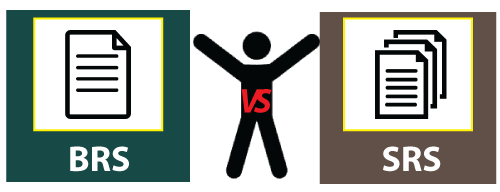In this section, we are going to discuss the difference between BRS and SRS and see a brief introduction between them.
The BRS and SRS are the most important documents to develop any project or software. These types of the document contain the in-depth details of the particular software.
In software testing, BRS and SRS types of document requirements depend upon business type, their standards, how company processes, and what class of software is to be developed.
Before we understood the difference between BRS and SRS, we will look into the difference between requirement and specification.
Requirement vs Specification
In the below table, we have made a comparison between requirement and specification.

|
Requirement |
Specification |
|
They plan
the software from the end-user, business, and stakeholder perspectives. |
They
prepare the software from the technical team's point of view. |
|
The
requirements define what the software must do. |
The
specification defines how the software will be developed. |
|
Some of
the common terminologies used for requirement document are as follows:
|
Some of
the common terminologies used for specification document are as follows:
|
Now, let's see a brief introduction to BRS and SRS documents.
What is
BRS?
The BRS document stands for Business Requirement Specification. To
create the BRS document, the Business
analyst will interrelate with the customers. The BRS
document includes the business rules, the project's scope, and in-detail
client's requirements.
In this type of document, the client describes how their
business works or the software they need.
For the CRS, the details will be written in the simple business
(English) language by the BA (business analyst), which developers and the test
engineers cannot understand.
What is
SRS?
The SRS document stands for Software Requirement Specification.
In this document, the Business Analyst will collect the Customer
Requirement Specifications (CRS) from the client and translate them into
Software Requirement Specification (SRS).
The SRS contains how the software should be developed and given
by the Business Analyst (BA).
In other words, we can say that the SRS document is used to
covert the customer information into a detailed document, which can easily
understand by the developers and the test engineers.
Characteristic
of Software Requirement Specification
Some important features of the SRS document are as below:
- The SRS document is used to determine
the early cost of the software product.
- It is helpful to links the gap
between the developer and the user.
- Software requirement specification
works as an agreement between communicating parties.
The Key
difference between BRS and SRS documents
- SRS represented as System Requirement Specification while BRS represented as Business Requirement Specification.
- SRS defines the functional and non-functional needs of the software; on the other hand, BRS is a formal document, which specifies the needs given by the customer.
- The SRS document is developed by the SA (System Architect); on the other hand, the BRS is generally developed by the BA (Business Analyst).
- SRS is obtained from the BRS, whereas BRS is acquired from customer statements and their business needs.
Difference between BRS vs SRS

The below comparison table enlightens their significant differences between SRS and BRS in a quick manner:
|
S.NO. |
BRS (Business
Requirement Specification) |
SRS (Software
Requirement Specification) |
|
1. |
It is a document
that describes the requirements of the client using the non-technical
expression. |
It determines the
specifications of a software product more formally. |
|
2. |
It prepares the
report of the user connections. |
It specifies how the
clients communicate with the system with the help of use cases. |
|
3. |
In the BRS document,
it is not important to contain the references of figures and tables. |
It always includes
references to illustrations and tables. |
|
4. |
The BRS document is
obtained from relating to the client's requirements and taking responsibility
for them. |
The Software
Requirement Specification obtain from the Business Requirement specification. |
|
5. |
The BRS document
involved the product's future scope, keeping in mind the organization's
strategies for development plans. |
The SRS document
does not involve the scope of the product. |
|
6. |
In the BRS document,
all the client's requirements complete in all the details are together and
accessible. |
SRS document
describes the stepwise sequence of all the operations characteristics for
each module and sub-modules. |
|
7. |
The BRS Document is
prepared by a team of Business Analysts (BA) who interacts with the clients. |
The SRS document is
created by a team of System Analysts (SA), a technical expert. |
|
8. |
It defines, at a
very high level, which includes the functional conditions of the application. |
It specifies at a
high level where the functional and technical requirements of the application
are included. |
|
9. |
The BRS documents
cover all types of requirements. |
The SRS documents
cover all functional and non-functional requirements. |
|
10. |
The BRS document
lists the user base along with similar stakeholders from the client-side. |
The SRS document
doesn't list anyone from the client or user base. |
Conclusion
In this section, we have made a comparison between BRS and SRS
documents.
Finally, we can conclude that the programmers used both the
documents in the development process and for the testing process.
The Business Requirement Specification (BRS) is a formal document that specifics the
customer's requirement, written or verbal.
Simultaneously, the Software Requirement Specification (SRS) document defines the functional and
non-functional needs of the software to be established.



0 Comments